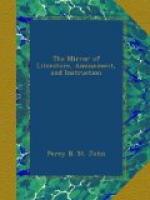The most remarkable fish of these rivers are, the peri or omah, two feet long; its teeth and jaws are so strong, that it cracks the shells of most nuts to feed on their kernels, and is most voracious; the Indians say that it snaps off the breasts of women, and emasculates men. Also the genus silurus, the young of which swim in a shoal of one hundred and fifty over the head of the mother, who, on the approach of danger, opens her mouth, and thus saves her progeny; with the loricaria calicthys, or assa, which constructs a nest on the surface of pools from the blades of grass floating about, and in this deposits its spawn which is hatched by the sun. In the dry season this remarkable fish has been dug out of the ground, for it burrows in the rains owing to the strength and power of the spine; in the gill-fin and body it is covered with strong plates, and far below the surface finds moisture to keep it alive. The electric eel is also an inhabitant of these waters, and has sometimes nearly proved fatal to the strongest swimmer. If sent to England in tubs, the wood and iron act as conductors, and keep the fish in a continued state of exhaustion, causing, eventually, death: an earthenware jar is the vessel in which to keep it in health.
(To be concluded in our next.)
* * * * *
FINE ARTS.
* * * * *
CROSSES.[6]
[Illustration: Neville’s Cross.]
We resume the illustration of these curious structures with two specimens of interesting architectural character, and memorable association with our early history. The first is Neville’s Cross, at Beaurepaire (or Bear Park, as it is now called), about two miles north-west from Durham. Here David II., King of Scots, encamped with his army before the celebrated battle of Red Hills, or Neville’s Cross, as it was afterwards termed, from the above elegant stone cross, erected to record the victory by Lord Ralph Neville. The English sovereign, Edward III., had just achieved the glorious conquest of Crecy; and the Scottish king judged this a fit opportunity for his invasion. However, “the great northern barons of England, Percy and Neville, Musgrave, Scope, and Hastings, assembled their forces in numbers sufficient to show that, though the conqueror of Crecy, with his victorious army, was absent in France, there were Englishmen enough left at home to protect the frontiers of his kingdom from violation. The Archbishops of Canterbury and York, the prelates of Durham, Carlisle, and Lincoln, sent their retainers, and attended the rendezvous in person, to add religious enthusiasm to the patriotic zeal of the barons. Ten thousand soldiers, who had been sent over to Calais to reinforce Edward III.’s army, were countermanded in this exigency, and added to the northern army.[7]”




